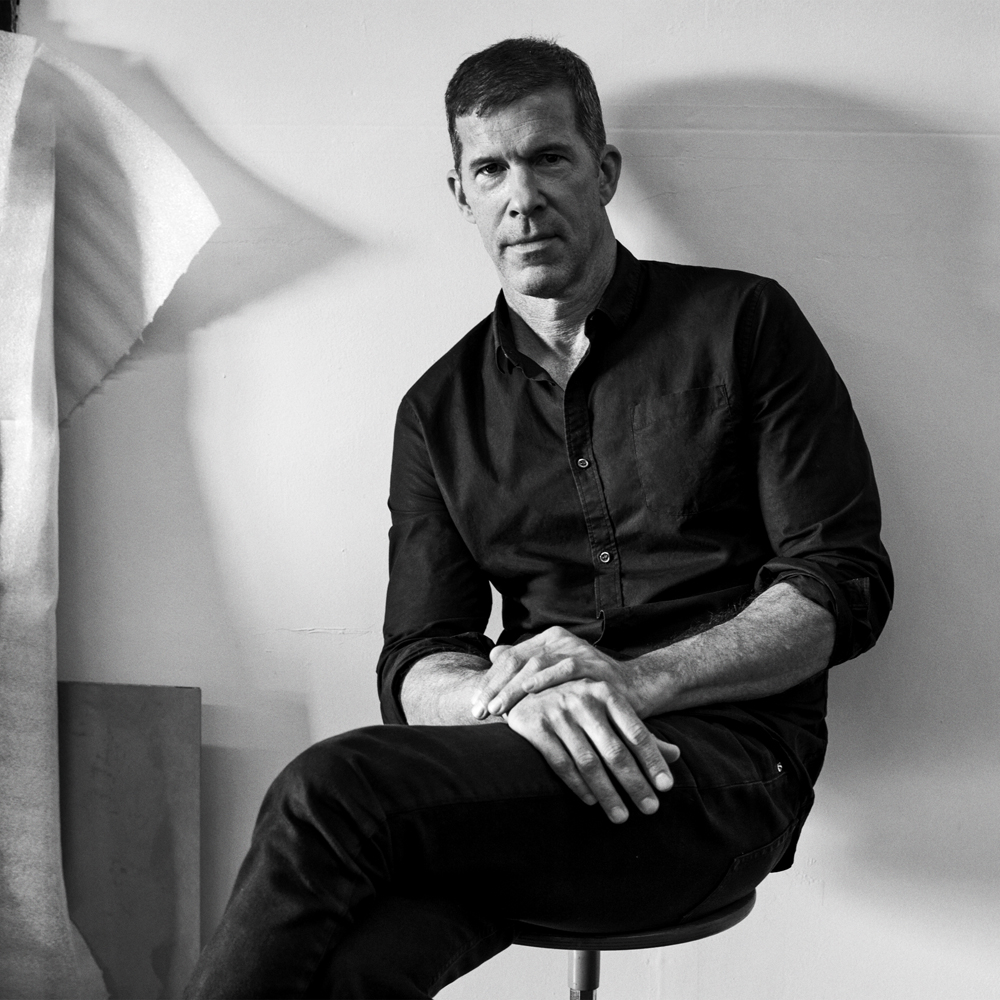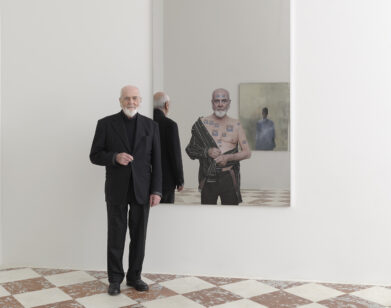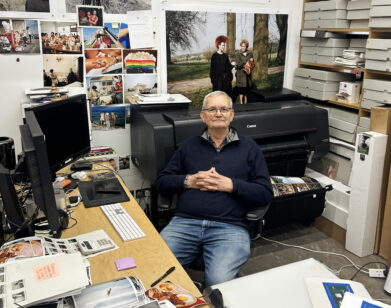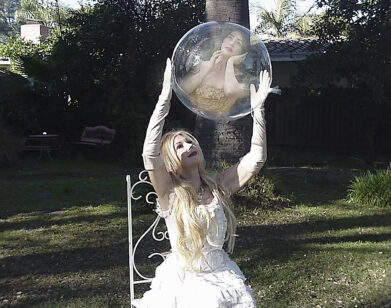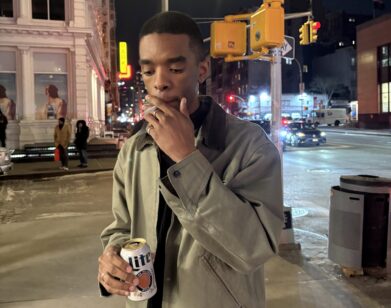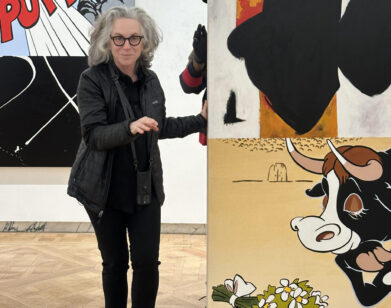Tom Burr
Decoys. Humor. Eros. Thrills. To encounter a Tom Burr artwork is to feel a sublime, unnerving itch. His sculptures are fastidiously produced expressions of collective memory that somehow, in the best way, leave you wanting more.
A native of New Haven, Connecticut, Burr moved to New York City in 1982 to attend the School of Visual Arts and then the Whitney Independent Study Program. By the early ’90s, he was exhibiting at the pioneering downtown gallery American Fine Arts, and experimenting with sculptural relations to public spaces in a way that would come to define his career. This prolific period resulted in several iconic works investigating the loss of sexualized meeting places in America and beyond. Using soil, rocks, trees, and other plantings, An American Garden (1993) reinvented, to scale, a swath of Central Park’s notorious gay-cruising and bird-watching spot the Ramble; Unearthing the public restrooms (1994) incorporated photographs of Manhattan restrooms closed during the 1980s in response to the AIDS crisis; Circa ’77 (1995) re-created another former gathering space for the sexually intrepid: Platzspitz park in Zurich, complete with beech trees and discarded bottle caps.
Corporeal but rarely physical (or at least not in a way that permits mess), Burr’s work is nostalgic but unsettling. His Brutalist Bulletin Board (2001) collages were a dance-off in polemics: cumbersome, brutish buildings set in juxtaposition with sensuous images of Jim Morrison. With Burr, the takeaways are always myriad, as are the entry points into his work. In 2000, in a rather ballsy prod at the strictures of site-specificity, Burr unveiled Deep Purple, a plywood remake of Richard Serra’s infamous 1981 piece Tilted Arc, which replicated the original’s curve and proportions, but unlike Serra’s steel structure (which could only exist in New York’s Federal Plaza), Burr’s was adaptable and mobile, and could be shown almost anywhere. This winter, the 53-year-old artist is tackling another architectural icon as part of an exhibition called “Question the Wall Itself” at the Walker Art Center in Minneapolis. Burr’s commissioned piece, Zog (a series of setbacks), references the zigzag design of architect Philip Johnson’s nearby IDS Center building which allowed for more corner offices per floor.
Tom and I have homes in the same small town in northwestern Connecticut, and for a while, we had New York apartments just city blocks apart. Though we’ve known each other for years, we’ve never really talked about his work before. For one thing, the average size of his sculptures (picture a small elephant) means he doesn’t keep them lying about. For another, he’s intellectually generous and deeply courteous. I don’t think I knew how celebrated he was until maybe three years into our friendship, and I certainly didn’t hear about his fame from him.
COURTNEY MAUM: It’s 11:30. Are you a coffee or a tea man?
TOM BURR: Well, actually tea. I used to drink coffee all the time, but it’s not on my regimen.
MAUM: What brand of tea?
BURR: I drink herbal tea, like, really weird shit.
MAUM: That’s so sad.
BURR: I know.
MAUM: It was interesting when I was asked to interview you—I had to do a lot of research! We’ve known each other for about seven years, but we never really speak about our work. We talk about other peoples’ work, but we’ve never gotten down into the ditches about your art.
BURR: It’s true.
MAUM: I think that’s due in part to your humility. How, in a culture so driven by self-promotion, do you manage to talk about yourself so rarely?
BURR: You know, I have a kind of work mode that I slip into and then I turn it off. I’m also super-conscious of how incredibly boring most artists can be when they start to go on autopilot, and I promised myself that I would never submit anybody to that kind of torture.
MAUM: There’s also this town-versus-country life that you have, too. I know for myself when I’m in New York, I’m full steam ahead, being social, getting things done. Then I come back here to Norfolk, and I don’t talk to people for days.
BURR: It has been that way for me, but it can also be the exact opposite because I kind of keep banker’s hours in New York, and I really do spend an awful amount of time by myself, working quite a lot. It was my solution to get a place outside the city and have this dialectic between two places. I get excited going in both directions. I find that I tend to be much more social when I’m up here in Connecticut. I mean, this is when I want to have dinner parties and things that have nothing to do with being around my work in any way.
MAUM: I was reading your text from 1993, “Just Outside the Museum …” in which you discuss areas of Central Park that used to be sexual gathering places. I absolutely love that you refer to the well-trodden paths among the magnolias and the pine trees behind the Met as “desire lines.” It’s such a beautiful image—did you coin this term?
BURR: I didn’t. I’ve used it a lot, but it actually comes from landscape architecture. It’s that path that is off the official path, and it’s an interesting theory to think about. You know, we have a problem right here in our town of Norfolk, where there’s the bank and some steps, and then there’s an official path that goes off to the left, and for years, there’s been this little path that gets trodden through the existing—
MAUM: The desire to get to the ATM.
BURR: Correct. To get to the ATM through the parking lot, and then it gets covered up and covered up. There’s something very interesting about that rather than planners thinking, “This is where people would like to walk, so let’s re-organize the path in that direction.” There’s a lot of humor in it, but it does seem to talk about how space is structured and how power works and how discipline works, and how spaces are disciplined in the same way as other things. In Central Park, those sorts of things were so poignant in relationship to these two constituencies: gay men particularly and also bird watchers. These two groups that were sort of simultaneously occupying the Ramble.
MAUM: Conceptual art is highly referential. For someone like myself, who isn’t in the visual art world, I was struck by how the formalist language used by critics to describe your work keeps the work itself at a distance. Is it frustrating or freeing to describe what you do to people who aren’t industry insiders?
BURR: When I went to school and was thinking about art making, there was a desire to break boundaries between the traditional making with paint and sculpture. That’s when I started using the term sculpture. I used it somewhat ironically at first because I thought, “Well, this is the easy answer, and this gives people something to hold on to, to chew on, something that they know.” It usually evokes a chisel or clay. It usually implies statues. But that’s what I would throw to people “outside of the industry,” rather than getting into some of the annoying subtleties of what it is I think I do that is not necessarily relevant to how people might perceive the work.
MAUM: It’s funny, though. If you say to someone, “Oh, I’m a sculptor,” you really still do picture a statue or a standing object, and that’s so antiquated. A man caked with a little bit of dried clay …
BURR: Brancusi or somebody.
MAUM: Yeah, someone hacking away at marble.
BURR: It is ridiculous, isn’t it? It’s a cartoon. Then I started to add the word architectural after it, which would—
MAUM: Get people at parties going, “Oh, I’ll walk away from this guy because I have no idea what he’s saying.”
BURR: Right. Which is always a good thing. [laughs]
MAUM: Let’s revisit your Unearthing the public restrooms piece where you photograph now-closed public restrooms in Manhattan that were used for both biological and sexual release. These photographs feel strangely prescient, but also charming. The separate entrances divided by gender: men, women. Have you thought about revisiting this work now that public-restroom segregation—by gender expression this time—is in the cultural spotlight again?
BURR: I presented that piece again in 2015 with the Bortolami gallery—it’s become sort of an iconic artwork of mine. I have thought about that, and it’s the reason I wanted to show it again without any kind of updating. It’s interesting that this discourse around nongendered bathrooms is going on, within our culture generally, but within the discussion about trans culture, too. One of the things about working over decades is the cumulative and the durational effect of work. That the updating process of a work happens less in changing the work than the way it’s being read for a specific time.
MAUM: A lot of your earlier work dealt with public spaces that had become sexualized through public use. I’m thinking specifically of An American Garden and Circa ’77. What are your thoughts about the future of social meeting spaces in America? The writer John Rechy has a great description of Central Park, in which he describes lovers experiencing the “last moments of exiled excitement.” What do you think about our era? Will the cultural underground still have physical places to meet? Or will everything move online?
BURR: This is quite a bit what I was thinking about in that recent Bortolami exhibition. Because Circa ’77 was also in the show—and it hadn’t been shown in this country before. It’s a work from 1995 that was about a park; different from Central Park, a park in Zurich, Switzerland that had its own history, its own set of coordinates that went along with it. And in the second room was a project called “Grips,” which were plates of steel leaning against each other with imagery of urban moments printed on certain sections—bits of buildings, glass reflections, some images of my feet. All of these images were taken with my iPhone as opposed to the Polaroid that I often used in the ’90s, and I was thinking, “Are there public spaces that are no longer speculated? Are there empty spaces? Are there spaces zoned for reinterpretation?” It goes a bit back to your question about desire lines, and while I wouldn’t conclude that that’s completely gone, I do think it has radically changed. I think we’re going through a whole reassessment and reexamination by looking back at the ’90s right now; there’s a fascination with this period. There’s some notion of there being more freedom then. Hopefully, in my work, I’m exploring the notion that there were always restrictions, and there were always sets of coordinates structuring what we do and what it feels possible to do. I think there’s a totalizing effect with the internet and living online that we’re only feeling now. The internet is like a surround system, a landscape at its most benign, a closed system of surveillance (and self-surveillance) at its more sinister. Something we can no longer imagine an outside of.
MAUM: I want to talk about something that both disturbs and enthralls me about your work. Across the board, there’s a studious remove that leaves the viewer longing for something they can’t have—a certain level of voyeurism is suggested but never fully permitted. For example, in “Dressage” [2013], we see structures and equipment used by horses and riders. But there aren’t any horses, and there aren’t any riders. The same thing happens with Put Down I, Put Down II, and Put Down III [all 2003]—girths, stirrups, silver bits—there’s all this equestrian equipment, but no horse, and so the mind wanders to S&M. To bondage. But there’s no one being bound. Or even pieces like Unplug Me, Please (in Purple) [2009] that showcase worn clothing but not the wearer. So, what to make of the fact that you often evoke presence through absence? Is sexuality inherently more interesting when it’s mysterious? Or do you just enjoy putting the viewer’s imagination to work?
BURR: I like the different pieces you cited because it shows a strange consistency in my work over the years, or maybe a repeated posturing, but there are a number of ways I can answer this. Coming out of feminism and the AIDS crisis in the 1980s, there was always a need to picture something, to picture the body, and I was interested in doing something very different than that. I was interested in implicating the viewer, and, for instance, with “Dressage”—it was shown in a plaza just outside where a former military horse stable had been for Art Basel in Switzerland—I was interested in the projection into the work by the bodies that might be viewing it. Similarly, the earlier Put Down pieces formed an installation with another work, Put Outs [2003]. In Put Outs, there were these three horse cages I had manufactured by an equestrian company, but we took the scale down so they had a less anxious relationship to the human body. I wanted there to be this kind of slip and collapse. Of course, I was aware that S&M would come up in relationship to the Put Down pieces, which were all equestrian tack. There’s the idea of discipline in that whole set of structures that we find beautiful in some ways, and then we immediately put the human body in that scenario. There is something extraordinary and perverse about it. I was interested in how it might throw the notion of discipline into sharper focus.
MAUM: Why do people often ask you if you believe in ghosts?
BURR: Funny, it always comes up. A lot of my work deals with sites and also this notion of absence. After working with the notion of public space, whether it be parks or bars or New York City generally or urban environments, I started to think about the notion of the figure and sculptural relations to that, and I did these white hinged works that mimic reclining figures made out of painted plywood panels (mostly white, sometimes black)—that often dealt with the idea of persona. Many of these figures were people who had died or sort of publicly decayed or had been celebrities. I think that led to people thinking about this notion of past lives, of residue.
MAUM: At a book event, someone once came up to me and said, “What’s with the hands? Your characters are always reaching for other people’s hands.” I was completely taken aback—I had no idea, but it’s true. Are you yourself aware that you have a thing for chairs? They’re often appearing knocked over in your pieces, and you even wrote an ode about them in one of your essays.
BURR: The chair thing, yeah. I think it was a way to start thinking about the body in a different way. I thought about the notion of structural things that were akin to sculpture, and chairs became very interesting as being almost a line drawing of what a body might be or where a body might sit, and then it’s easy to immediately create a sense of both comedy and pathos by shifting that. They become fetishes in that way, and you can play with them in a sort of sculptural mise-en-scène. And that activated these theatrical spaces. They’re surrogates on some level for participants, a compromised body, a body that’s always in decline.
MAUM: You wrote that you’re “at once attracted to and repulsed by the aesthetics of designed objects and spaces.” Could you talk about this repulsion?
BURR: I had a lot of fantasies about being an architect when I was young, and I think I still do. On a visceral level, I’m very intellectually and emotionally attracted to acknowledging how space functions in our lives, both in terms of pleasure and in terms of control, and in terms of all those factors that form a life. I’m also very anxious and maybe repulsed by how superficial that whole dialogue can become. I also find the categories incredibly profound—you know, it’s the difference between minimalism and Calvin Klein’s take on minimalism. I’m attracted to both.
MAUM: I’m obsessed with the Crate and Barrel catalogs because they dictate the life they think people should aspire to, and it’s so weird to see what “the man” thinks our wine glasses should look like, and what nuts we should be serving. Then there are the design blogs. The word hack makes me nauseous.
BURR: That’s the response I have, too. We’ve seen the rise of the lifestyle industry in a way that had never existed before, and it feels like the envelope is a little too tight—the profiting on desire in a way.
MAUM: I spend a ridiculous amount of time thinking about the rise of succulents, and how marketing and branding has inserted a desire into people of a certain economic class in America to own cacti. Am I alone in being obsessed with this?
BURR: No, my mind was racing as soon as you said “succulents,” and I feel like I see them everywhere, in print ads, everywhere. It’s sort of indicative of how culture forms us.
MAUM: Pivoting from cacti: Do you think your work is received differently abroad than it is here in the U.S.?
BURR: It’s not easy for me to answer this. I had, earlier, a lot more opportunities in Europe. There are a lot of artists who had a similar trajectory where work seemed to be received in one place more than another. I do think of my work, however, as being quintessentially American in that it could only have emerged in that particular situation that I find myself. I feel that a lot of my work is working on problems that might be specifically American problems, but not exclusively.
MAUM: Speaking of trajectories, were there any other career paths for you? What would you do if you weren’t doing conceptual art?
BURR: Maybe I would have been a sculptor. [laughs] You know, I talk about incorporating architectural qualities into my work, but it’s one of those questions that makes me panic because I think, to a certain degree, when art-making became a way of life, I limited my choices. I had some notion of what it meant to be an artist when I was young, and it turned out to be quite different than the reality. I didn’t know that there was going to be quite as much business as I found out there is. And perhaps that was my early perception of architecture, too. That I was very intrigued by it, but that there was going to be too much negotiation, too much …
MAUM: Client interfacing.
BURR: Exactly. Group decision-making and these kinds of things. Of course, art-making is not that dissimilar really, but the outward image of it is one of complete freedom and choice. But in a way, art has always been my way of problem-solving, of getting through situations, of finding my response to things, so to imagine doing something else makes me panic a little bit.
MAUM: Let’s do a little free association. I’ll say a word and you react however you want to. Surrogate.
BURR: My first response was something quite dumb. I think of vessels, like vases and things, and I think that comes out of Allan McCollum, who is an artist who did a “Surrogates” series, and also made vessels and other objects, and whenever I hear surrogate, I just have this vase in my mind.
MAUM: Decoy.
BURR: I’m feeling very dumb today. I thought of a duck.
MAUM: There’s nothing wrong with that. Precariousness.
BURR: Career. [laughs] Precariousness is just a general condition that I feel describes our cultural place right now, and of course, my career is part of that cultural place. Precariousness is a word that seems to sum up exactly what we’re negotiating right now.
MAUM: Well said. Grace.
BURR: Umm …
MAUM: He is staring out the window …
BURR: I’m looking for grace. I’m always looking for grace. Why does that one silence me? It does a bit. Grace, I seem to associate it with silence and, I don’t know, death.
MAUM: Displacement.
BURR: My work. I think displacement is always a strategy. I think strategy sounds a little bit too intentional maybe, but it is always a tendency within my work to displace things. Like what does it mean when you take an object like a video booth as I did in “42nd Street Structures” [1995] and put it in a gallery? This is the kind of displacement that I play with.
MAUM: Longing.
BURR: Um, everything. That’s desire. Longing is the fullest sense of desire; it’s the most deeply felt kind of desire. I think the most interesting artwork comes out of some sense of longing. It could be called dissatisfaction; it could be called distance. There are many kinds of wanting to get closer to something else, whether that is an idea, a body, a place. Longing is also one of the conditions people approach reading, visual art, or music with—it’s to satisfy that sense of longing. It’s part of my job, on some level, to grapple with that notion.
MAUM: Do you procrastinate? If so, what does it look like?
BURR: I do, and usually it looks like an empty Word document. I do a very complicated editing process with my work. I tend to write rather than sketch in a formal way. And I visit spaces a lot. My happiest times are usually when I know there is a project ahead of me and I am not under an immediate deadline. And then the deadline comes in …
MAUM: The work doesn’t really function if you don’t have an audience.
BURR: Exactly. That goes back to presence and final viewing. In some ways it’s a hard process to imagine, and that’s where some of the procrastination comes in. I find that deadlines form part of the aesthetic. I don’t have that “It could only have been this way” kind of thing. I tend to rewrite it and say that after the fact, but on the way there, there are just some routes that you have to give up and make decisions, and that decision-making I find torturous. But I’m used to that torture.
MAUM: What are you working on now?
BURR: I’m working on a few things. I have a show at the Walker starting in November. I’m showing a large work called Zog. It’s a large series of cabinet-like structures that is responding in some ways to the compartmentalization of spaces. Zogs are what Philip Johnson called the zigzag stepbacks in the façade of his IDS Center building, which is the most prominent building in Minneapolis. I’m also working on something that is especially exciting to me. In New Haven, Connecticut—the city I was born in—I’m doing a yearlong project that will take place in the Marcel Breuer building that is now owned by IKEA in the Long Wharf area. It’s a building that was built from 1968 to 1970 for the Armstrong Rubber Company, which made tires. A Brutalist concrete building …
MAUM: Is it the one that’s right in front of the IKEA blue-and-yellow store?
BURR: That’s right. IKEA bought it, they took down the warehouse part, and then the rest of that is preserved. It has to be maintained because it’s a designated landmark.
MAUM: Whenever I passed that, I always thought, “What is going on?”
BURR: I thought, “Could we do a project there?” Everybody said, “There’s no possible way you can get in there. Even the architecture freaks have not been able to get in this building.” We approached IKEA, and they want to find a use for it. It doesn’t fit how they do their stores; they have these models for their buildings. So there’s a structural installation I’ll be working on over the course of a year in that space. We’re going to be working on the lower floors. There’s a big space between the upper and lower floors that Marcel Breuer designed, because the lower floor was for research and development, where the tires were tested, so there was a lot of noise and a lot of screeching.
MAUM: It’s so funny that they used to make tires there, because in that exact area, there’s always a traffic jam. It doesn’t matter what season or what hour. And you’re right next to the water. So there’s this opportunity for freedom right there when you’re in gridlock.
BURR: I know, and the windows look right out on I-95. Those buildings were built for the reconstruction under Mayor [Richard] Lee, who was this well-known mayor who brought all of this modernist architecture to New Haven in a very complicated urban renewal project. He wanted a signature architect, and he wanted to redefine the entrance of the city that had been redefined by the presence of I-95. And now it’s a complex relationship. It’s this ghost—to use this term—standing in the middle of the IKEA parking lot.
COURTNEY MAUM IS A CONNECTICUT-BASED AUTHOR. HER FORTHCOMING NOVEL, TOUCH, WILL BE OUT IN JUNE.

